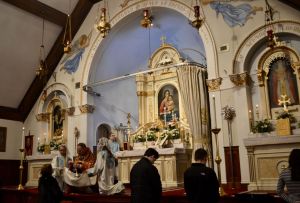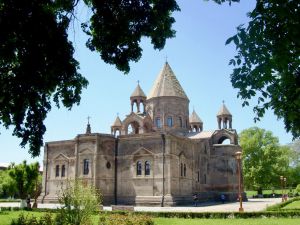
An Armenian Easter table with colored eggs and a gata (traditional Armenian pastry), Amherst, MA. Photo by Kristina Afrikyan.
Share This
Print This
Email This
Discovering the Meaning of Armenian Easter
Growing up in the 1990s’ post-Soviet Armenia, I had a rather vague idea about what Easter represented and why we celebrated it. I heard the words “resurrection,” “renaissance,” and “eternity” but did not quite understand what all that was about. What I knew was that every spring, right around my birthday, we celebrated a religious holiday. That meant going with my mother to the grocery store earlier in the week to buy trout for the Saturday night dinner and eggs, tarragon, and lavash (Armenian flatbread baked in a tandoor) for the Sunday breakfast. The most anticipated event of the Easter celebration for my peers and me, however, was the egg fight. According to the Armenian Easter tradition, we boil and color the eggs, and then we fight them: the aim is to crack the opponent’s egg. Later I discovered that this tradition was only one tiny-and-not-quite-central segment of the celebration. Yet, it was just as exciting and fun for adults as it was for the children and the youth. After all, my father was one of my most enthusiastic opponents during these extraordinary “battles” every Easter Sunday morning throughout my childhood.
In my family, these egg fights would take place around the breakfast table while we watched the live broadcast of the Easter Sunday service from the Mother See of Holy Etchmiadzin—the religious center of Armenians—led by the Catholicos of All Armenians. To my six-year-old self, this service represented a combination of beautiful, almost magical melodies and songs and several priests dressed in expensive mesmerizing attire, performing rituals. My knowledge of religion, religious traditions, and practices was minimal at that point, as you might have already guessed. Why? How could a child growing up in a country proud to be the first Christian nation in the world know so little about one of the major Christian holidays? These questions did not occur to me until later in life. They became vital after I moved to another country and realized how different it was to be an Armenian outside Armenia.
Armenia is indeed one of the oldest Christian nations in the world. Surrounded mostly by non-Christian and almost always non-friendly yet much more powerful empires, kingdoms, and states, Armenia has suffered immensely and struggled continuously to preserve its Christian traditions and culture. Positioned at the intersection of geopolitically competing interests of a number of powerful states, the Armenian nation has persevered through numerous wars, atrocities, even a genocide and has regained its independence and built a democratic state. Many Armenians believe that they have achieved all this due to their faithfulness to and appreciation of the Armenian language, culture, and the Armenian Apostolic Church. Just imagine, even as part of the Soviet Union—an atheist state per se—Armenia, albeit secretly, managed to preserve those traditions. I remember hearing the stories of my mother and my uncles being baptized clandestinely since they had to organize an entire secret operation of smuggling a priest in and out of their house without the neighbors noticing it. Yet, those seventy years of communist rule impacted the religious practices immensely. Many of the Christian customs had to be secularized if Armenians still wanted to celebrate their traditional holidays. And this was partly the reason why in the immediate post-Soviet years, Easter in Armenia had become more about egg fights and less about the celebration of Christ’s resurrection.
Meanwhile, when we highlight the strong ties of the Armenians to their roots and customs, not only are we talking about the Republic of Armenia, but also about the vast Armenian diaspora scattered all over the globe. Diaspora Armenians, forced outside their ancient homeland due to genocide, had to create a home away from home, facing countless challenges, yet believing in rebirth and resurrection. Only after joining this powerful and simultaneously quite vulnerable entity—the Armenian diaspora—in the United States did I truly understand the critical significance of cultural education and connectedness. I saw families dressing up every Sunday for the service, even if it were a few hours’ journey to the closest Armenian church. I saw Armenian American children attending Sunday schools to learn Armenian and study the history, and their parents and grandparents seizing every opportunity to create new and preserve the long-existing community networks.
Every Easter Sunday communities from California and Texas to Massachusetts and Florida organize big celebration events in the Armenian churches. Everybody greets each other with “Kristos haryav i merelots, orhnyal e harutyune Kristosi!” (“Christ is risen from the dead, blessed is the resurrection of Christ!) on this day. At the beautiful Sunday morning service, priests remind their followers that the resurrection declares life’s victory over death, and together they pray for the well-being of local community members and Armenians around the globe. Then the gathered guests proceed to a large hall, usually called a cultural center, adjacent to or in the basement of the church. There they hold a festive brunch serving delicious Armenian pastries called choreg and gata, baked by the community member-volunteers, and, of course, colored eggs. Sometimes these events also include cultural programs and performances by the young students of local Sunday schools, reciting Armenian poetry and singing and dancing to Armenian traditional songs.

A Sunday service at Holy Trinity Armenian Church of Greater Boston, Cambridge, MA. Photo by the author.
As an Armenian historian and an educator, I was invited to many such events over the past ten years, and I eventually became part of these fascinating communities. Soon, I realized that while I educated them on human rights and genocide prevention, they educated me about what it meant to be an Armenian outside of an Armenian state. And, among other things, they taught me that Easter for Armenians was not just a regular holiday; it was the symbol of new life, the indication of and the testimony to their resilience and perseverance.








Great article!!!
Informative & interesting
I liked the article and was moved by it since I have relatives (or their descendants) who emigrated just before WWI and others who were caught up in the momentous changes of that era, and now live in the Republic of Armenia rather than in the Soviet Republic in which they grew up!
Yes, I remember the egg “fights” among the men outside the church after service or after the big dinner at home in California. And, though my mother dyed eggs with the pastel Paas dyes she also showed us some years how the traditional eggs were dyed with onion skins. We had “gata” but were surrounded in our community with other Armenians who usually made “cheorag”.